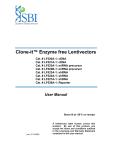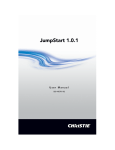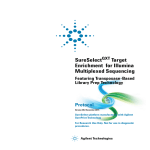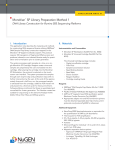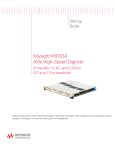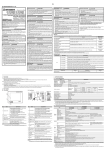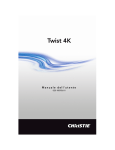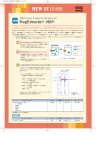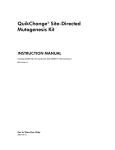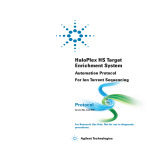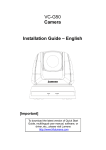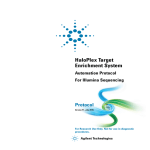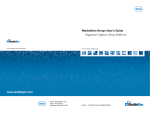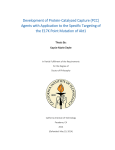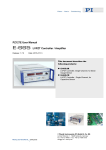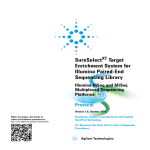Download SureCycler 8800 Setup and User`s Guide
Transcript
SureCycler 8800 Setup and User’s Guide Version C3, June 2015 For Research Use Only. Not for use in diagnostic procedures. Agilent Technologies Notices © Agilent Technologies, Inc. 2015 Warranty No part of this manual may be reproduced in any form or by any means (including electronic storage and retrieval or translation into a foreign language) without prior agreement and written consent from Agilent Technologies, Inc. as governed by United States and international copyright laws. The material contained in this document is provided “as is,” and is subject to being changed, without notice, in future editions. Further, to the maximum extent permitted by applicable law, Agilent disclaims all warranties, either express or implied, with regard to this manual and any information contained herein, including but not limited to the implied warranties of merchantability and fitness for a particular purpose. Agilent shall not be liable for errors or for incidental or consequential damages in connection with the furnishing, use, or performance of this document or of any information contained herein. Should Agilent and the user have a separate written agreement with warranty terms covering the material in this document that conflict with these terms, the warranty terms in the separate agreement shall control. Manual Part Number G8800-90000 Edition Version C3, June 2015 Printed in USA Agilent Technologies, Inc. 5301 Stevens Creek Blvd Santa Clara, CA 95051 USA Microsoft ® is a trademark or registered trademark of Microsoft Corporation in the United States and/or other countries. Technical Support For technical support, contact Agilent at [email protected]. Complete contact information for Technical Support is listed on page 14. Agilent SureCycler 8800 Manufactured by Agilent Technologies LDA Malaysia Sdn. Bhd. Bayan Lepas Free Industrial Zone 11900 Penang, Malaysia For Agilent Technologies Singapore (International) Pte. Ltd. No. 1, Yishun Avenue 7, Singapore 768923 www.agilent.com 2 Safety Notices Technology Licenses The hardware and/or software described in this document are furnished under a license and may be used or copied only in accordance with the terms of such license. Restricted Rights Legend CAUTION A CAUTION notice denotes a hazard. It calls attention to an operating procedure, practice, or the like that, if not correctly performed or adhered to, could result in damage to the product or loss of important data. Do not proceed beyond a CAUTION notice until the indicated conditions are fully understood and met. WAR NING A WARNING notice denotes a hazard. It calls attention to an operating procedure, practice, or the like that, if not correctly performed or adhered to, could result in personal injury or death. Do not proceed beyond a WARNING notice until the indicated conditions are fully understood and met. U.S. Government Restricted Rights. Software and technical data rights granted to the federal government include only those rights customarily provided to end user customers. Agilent provides this customary commercial license in Software and technical data pursuant to FAR 12.211 (Technical Data) and 12.212 (Computer Software) and, for the Department of Defense, DFARS 252.227-7015 (Technical Data - Commercial Items) and DFARS 227.7202-3 (Rights in Commercial Computer Software or Computer Software Documentation). Agilent SureCycler 8800 Setup and User’s Guide South Korean Class A EMC Declaration A 급 기기 ( 업무용 방송통신기자재 ) This equipment is Class A suitable for professional use and is for use in electromagnetic environments outside of the home. 이 기기는 업무용 (A 급 ) 전자파적합기기로서 판 매자 또는 사용자는 이 점을 주 의하시기 바라 며 , 가정외의 지역에서 사용하는 것을 목적으 로 합니다 . Document Part Number: 5061-7383 *5061-7383* © Agilent Technologies 2015 Agilent Technologies In this Guide... This document describes how to program and use the Agilent SureCycler 8800. 1 Before You Begin This chapter contains information for you to read and understand before you start. 2 Installation This chapter contains installation instructions for setting up the cycler instrument. 3 Getting Started This chapter contains instructions to load samples, get started with the software, set up user accounts and access instruments remotely via a network. 4 PCR Programs This chapter contains instructions to work with PCR programs, incubations and reports. Troubleshooting suggestions are also provided. 5 Maintenance and Updates This chapter contains instructions for maintaining the instrument and uploading software updates. 4 Agilent SureCycler 8800 Setup and User’s Guide Contents 1 Before You Begin 9 Materials Provided 10 Safety Precautions 10 Indicator LED Light 13 Overview 13 SureCycler 8800 Technical Support 2 Installation 14 15 Installation 16 Step 1. Select a location for the instrument 16 Step 2. Unpack the cycler 16 Step 3. Install the thermal block on the instrument base Step 4. Connect the instrument to a power supply 17 Step 5. Connect optional devices 17 Step 6. Turn on the instrument 17 Step 7. Connect the cycler to a network (optional) 17 16 Thermal Block Exchange 18 To remove the thermal block 18 To install the thermal block 18 3 Getting Started 19 Sample Preparation and Loading 20 To prepare samples 20 To load samples 20 Agilent Plasticware and Consumables Starting Up the Software 22 Touchscreen Operation of the Software Agilent SureCycler 8800 Setup and User’s Guide 21 22 5 Contents Home Screen 22 User Accounts 24 Access Levels 24 Logging In to User Accounts 24 Managing User Accounts 26 Network Settings and Remote Access 29 To view or edit the cycler’s IP address and name To access the cycler from another cycler 30 To access the cycler from a computer 31 To access the cycler from an iPhone 31 29 Cycler Settings 32 Hot Top Setting 32 Cycler name 33 Time and date 33 4 PCR Programs 35 Creating New PCR Programs 36 To manually create programs 36 To create a PCR program using the PCR Wizard 39 Tips for Creating PCR Programs for the 384-well SureCycler 8800 Program Steps in the Commands List Hot Start 43 Cycle Wizard 44 Start Cycle 45 Temperature Step 46 End Cycle 47 Gradient Step 47 Touchdown 49 Storage/Pause Step 50 43 Using a Preloaded PCR Program 51 To access the preloaded programs To edit a preloaded program 52 6 42 52 Agilent SureCycler 8800 Setup and User’s Guide Contents Editing PCR Programs 53 To edit program step parameters To copy a PCR step 54 To add or delete a PCR step 54 To delete a PCR program 54 Running a PCR Program 55 To run a PCR program 55 To stop or pause a program 53 55 Running an Incubation 56 To set up and run an incubation 56 Viewing Reports 57 To view reports 57 To delete a report 57 Troubleshooting 58 If PCR yield is low when running small reaction volumes with the Standard ramp rate 58 If no actual temperature is displayed during the run 58 If the program does not start 58 If condensation is found in tubes during a run 59 If the sealed microplate loses sample volume 59 If USB devices including memory stick and keyboard not recognized 59 If cycler does not turn on 59 If screen is blank and unlit 60 If screen is lit but shows no information or has missing characters 60 60 5 Maintenance and Updates Maintenance 62 Cleaning 62 Replacing a fuse Software Updates 61 62 63 Agilent SureCycler 8800 Setup and User’s Guide 7 Contents 8 Agilent SureCycler 8800 Setup and User’s Guide SureCycler 8800 Setup and User’s Guide 1 Before You Begin Materials Provided 10 Safety Precautions 10 Indicator LED Light 13 Overview 13 SureCycler 8800 Technical Support 14 This chapter contains information for you to read and understand before you start. For installation instructions, see “Installation” on page 16. Agilent Technologies 9 1 Before You Begin Materials Provided Materials Provided Table 1 Materials Provided Part Quantity SureCycler 8800 instrument base 1 Thermal block unit (96-well or 384-well)* 1 Power cord 1 USB external drive** 1 Functional test certificate 1 Quick Start installation poster 1 CD with Setup and User’s Guide PDF 1 * The thermal block units are sold separately as part numbers G8810A (96-well block) and G8820A (384-well block). **The USB external drive is provided for transferring files to and from the cycler as needed. We recommend using this drive for all file transfers on the cycler. Safety Precautions Electrical Standard electrical safety precautions should be applied, including the following: • Always put the instrument in a location where, if needed, the power supply can be immediately disconnected. • Proper voltage must be supplied before you turn on the instrument for the first time. • The device must be connected to a grounded socket. • Do not touch any switches or outlets with wet hands. • Turn off the instrument before you disconnect the power cord. 10 Agilent SureCycler 8800 Setup and User’s Guide Before You Begin Safety Precautions 1 • Unplug the instrument before you clean any major liquid spills and before you service any of the electrical or internal components or swap out the thermal block. • Do not operate the instrument from a power outlet that has no ground connection. • Do not service the electrical components unless you are qualified to do so. Fluids and Reagents • Fill reaction vessels outside the cycler so that no fluids penetrate the instrument. • Never cycle or incubate explosive, flammable and reactive substances in the instrument. • You must observe the relevant safety regulations when handling pathogenic material, radioactive substances or other substances hazardous to health. • Do not submerge the instrument in any liquid. Danger of Burns • Do not touch the thermal block, inner side of heated lid and reaction vessels. These areas quickly attain temperatures of greater than 50°C. Keep the heated lid closed until temperatures of 30°C or lower are reached. • Do not use any materials (plates, sealings, foils, mats) which are not sufficiently temperature-stable (up to 120°C). Operating Environment • The ventilation slots of the device must remain free to vent at all times. Leave at least 10 cm of space around the instrument. • Keep the ambient temperature between 20°C and 30°C with humidity levels between 20% and 80% non-condensing. • Do not operate the instrument in a hazardous or potentially explosive environment. Agilent SureCycler 8800 Setup and User’s Guide 11 1 Before You Begin Safety Precautions Equipment Ratings • Pollution degree 2 • Installation category II • Altitude 2000 m • Humidity 20 to 80%, non-condensing • Electrical supply 100-240 V, 50/60 Hz, 11 A • Temperature 20°C to 30°C • For Indoor Use Only Electrostatic Discharge The SureCycler 8800 is static sensitive. Electrostatic discharges greater than 8000 volts may interfere with the normal operation of the USB ports on the instrument. Handling precautions are required when working in high static environments. Wear a grounded wrist strap and take other antistatic precautions prior to making contact with the device in high static environments. ESD STM5.1-1998 Class 3B. Safety Symbols The electrical/safety symbols described below may be displayed on the instrument. Power on Power off Caution Caution, hot surfaces 12 Agilent SureCycler 8800 Setup and User’s Guide Before You Begin Indicator LED Light 1 Indicator LED Light On the front of the instrument (top right corner) is a status indicator LED. Table 2 summarizes the status codes for this LED light. Table 2 Appearance of the status indicator LED Appearance Instrument Status Off The cycler is idle. Blinking green The cycler is running a program or incubation. Solid green The cycler is paused. Blinking red The cycler has detected an error. Check the display for an error message containing further details. Overview The SureCycler 8800 is a thermal cycler designed to perform polymerase chain reaction (PCR) and related methods for amplification of DNA templates. The cycler can run even the most complex thermal cycling techniques, including time and temperature increments, touchdown PCR and temperature gradients. The software interface, operated through the color touchscreen, features an intelligent Program Wizard that can create PCR protocols automatically from primer and template information. Agilent SureCycler 8800 Setup and User’s Guide 13 1 Before You Begin SureCycler 8800 Technical Support SureCycler 8800 Technical Support Email USA and Canada: [email protected] Europe: [email protected] Japan: [email protected] All other countries: [email protected] World Wide Web www.genomics.agilent.com Telephone USA and Canada (800) 227-9770 Europe Austria 01 25125 6800 Benelux 02 404 92 22 Denmark 45 70 13 00 30 Finland 010 802 220 France 0810 446 446 Germany 0800 603 1000 Italy 800 012575 Netherlands 020 547 2600 Spain 901 11 68 90 Sweden 08 506 4 8960 Switzerland 0848 8035 60 UK/Ireland 0845 712 5292 Japan 0120-477-111 All other countries Go to www.agilent.com/genomics/contactus. 14 Agilent SureCycler 8800 Setup and User’s Guide SureCycler 8800 Setup and User’s Guide 2 Installation Installation 16 Step 1. Select a location for the instrument 16 Step 2. Unpack the cycler 16 Step 3. Install the thermal block on the instrument base 16 Step 4. Connect the instrument to a power supply 17 Step 5. Connect optional devices 17 Step 6. Turn on the instrument 17 Step 7. Connect the cycler to a network (optional) 17 Thermal Block Exchange 18 To remove the thermal block 18 To install the thermal block 18 This chapter contains installation instructions for setting up the cycler instrument. Agilent Technologies 15 2 Installation Installation Installation Step 1. Select a location for the instrument • Locate a solid, flat clean surface for the instrument. Make sure: • The instrument can stand completely stable. • The rear air slots will not be covered. • The unit always has at least 10 cm (approximately 4 inches) to the next wall or neighboring instrument. • The temperature (normal ambient) is between 20°C and 30°C with humidity levels between 20% and 80% non-condensing. • The atmosphere is not explosive. Step 2. Unpack the cycler 1 Open the shipping containers and unpack the contents. Detailed unpacking instructions are provided on the installation poster (packed inside the same box as the instrument base). Step 3. Install the thermal block on the instrument base 1 Using both hands, grasp the thermal block unit on the left and right sides and place it on top of the instrument base. 2 Firmly press down on both sides of the thermal block unit until it locks into place. Ensure both the left and right sides of the thermal block unit are locked in place by pressing down on both sides. The thermal block unit will only lock into place if it is placed on the instrument base in the proper orientation. For instructions on swapping out the thermal block, see “Thermal Block Exchange” on page 18. 16 Agilent SureCycler 8800 Setup and User’s Guide Installation Step 4. Connect the instrument to a power supply 2 Step 4. Connect the instrument to a power supply The instrument must be connected to a grounded AC outlet. 1 Plug the instrument’s power cord into the power connector at the rear of the instrument. 2 Connect the other side of the cable to the outlet. Step 5. Connect optional devices If desired, you can connect an optional USB device (such as a keyboard mouse or memory stick) to the instrument via the USB ports on the front of the instrument. 1 Plug the USB cable of the device into either USB port on the instrument. Step 6. Turn on the instrument 1 Press the power button located near the bottom left corner on the front of the instrument. You can turn off the instrument any time. You do not need to close the software before you turn off the instrument. Step 7. Connect the cycler to a network (optional) 1 Plug one end of an ethernet cable into the ethernet port on the back of the instrument. 2 Plug the other end of the cable into a network port. Agilent SureCycler 8800 Setup and User’s Guide 17 2 Installation Thermal Block Exchange Thermal Block Exchange Two interchangeable thermal block units are available with the SureCycler 8800: the 96-well block and the 384-well block. To remove the thermal block 1 Power off the instrument and disconnect the power supply. 2 Lift the lid off the thermal block by pressing firmly on the gray button on the top of the instrument. 3 Using both hands, grasp the thermal block unit on the left and right sides while using your thumbs to press down on the buttons in the upper left and right corners. 4 With the buttons firmly pressed, lift the thermal block unit up and off the instrument base. Use care when lifting the thermal block unit to avoid letting the lid fall closed on your hands. Keeping the unit tilted slightly away from you may help prevent the lid from falling closed. To install the thermal block 1 Using both hands, grasp the thermal block unit on the left and right sides and place it on top of the instrument base. 2 Firmly press down on both sides of the thermal block unit until it locks into place. Ensure both the left and right sides of the thermal block unit are locked in place by pressing down on both sides. The thermal block unit will only lock into place if it is placed on the instrument base in the proper orientation. 3 Reconnect the power supply when finished. 18 Agilent SureCycler 8800 Setup and User’s Guide SureCycler 8800 Setup and User’s Guide 3 Getting Started Sample Preparation and Loading 20 To prepare samples 20 To load samples 20 Agilent Plasticware and Consumables 21 Starting Up the Software 22 Touchscreen Operation of the Software 22 Home Screen 22 User Accounts 24 Access Levels 24 Logging In to User Accounts 24 Managing User Accounts 26 Network Settings and Remote Access 29 To view or edit the cycler’s IP address and name 29 To access the cycler from another cycler 30 To access the cycler from a computer 31 Cycler Settings 32 Hot Top Setting 32 Cycler name 33 Time and date 33 This chapter contains instructions to load samples, get started with the software, set up user accounts and access instruments remotely via a network. Agilent Technologies 19 3 Getting Started Sample Preparation and Loading Sample Preparation and Loading To prevent damage to the block and the heated lid, use only temperature-stable sample tubes and plates. Unsuitable tubes and plates can become damaged during cycling. See “Agilent Plasticware and Consumables” on page 21 for a list of recommended plasticware. WARN I NG Danger of Burns: The thermal block, sample tubes and plates may reach temperatures as high as 100°C. Keep hands away until temperature is 30°C or less. To prepare samples Keep the following guidelines in mind when preparing samples in reaction plates and tubes: • Place caps on tubes before loading samples into the thermal block. • For best results, just before loading the samples into the thermal block, spin them briefly in a centrifuge. • If using sealing film to cover a reaction plate, use a compression mat during cycling to ensure the film stays firmly adhered to the plate. See “Agilent Plasticware and Consumables” on page 21 for ordering information on a compression mat. To load samples The instrument can be loaded with individual PCR tubes or strip tubes or, depending upon the thermal block installed, one 96-well PCR plate or one 384-well PCR plate. 1 Lift the lid of the thermal block by pressing firmly on the button on the top of the instrument to unlatch the lid. 2 Put your plate or tubes on the block and check that they are correctly positioned. On the 96-well block, seat the tubes in the round holes on the thermal block. On the 384-well block, seat the tubes in the larger round holes. 3 Close the lid until it latches into place. 20 Agilent SureCycler 8800 Setup and User’s Guide Getting Started Agilent Plasticware and Consumables 3 Agilent Plasticware and Consumables The following PCR plates, reaction tubes and sealing films are compatible with the SureCycler 8800: Agilent Part Number Description 401333 96-well plate, 25-pack 410188 384-well plates, 50-pack 410186 Adhesive sealing films, 100-pack 410187 Compression mats, 10-pack 410082 Strip tubes, 200 l, 80 strips of 12 410086 Strip tube caps, 80 strips of 12 Agilent SureCycler 8800 Setup and User’s Guide 21 3 Getting Started Starting Up the Software Starting Up the Software Touchscreen Operation of the Software The color touchscreen allows you to operate the software by touching the buttons on the screen. If a mouse has been connected to the instrument, you may select buttons by clicking. When software functions require data input from a keyboard, the software automatically displays a virtual keyboard operated through the touchscreen. Data may also be entered using a USB-connected keyboard. Home Screen Shortly after turning on the instrument, the touchscreen displays the Home screen. This screen is the starting point for all the software-controlled instrument operations as well as file and account management. Each navigation button on the Home screen menu takes you to a different functional area in the software. The table below describes the function associated with each navigation button on the Home screen: Table 3 22 Home Screen Button Descriptions Button Description New Program Use this button to create a new PCR program. Programs Opens the file directory to browse stored PCR programs. Use this button to edit or run programs. PCR Wizard Use this button to create a new PCR program using a guided Wizard. Network Control Use this button to connect to multiple instruments via a network. Incubate Starts a single temperature incubation for a predefined period or for an indefinite hold. Reports Opens the report directory allowing you to browse for stored report files. Agilent SureCycler 8800 Setup and User’s Guide Getting Started Home Screen Table 3 3 Home Screen Button Descriptions (continued) Button Description Login Opens the Login screen. Settings Use this button to adjust cycler settings, upgrade software and manage user accounts. Agilent SureCycler 8800 Setup and User’s Guide 23 3 Getting Started User Accounts User Accounts Access Levels When the instrument is powered on, the Guest account is automatically logged in to the software. Three different access levels are available for user accounts: Administrator, Registered user, and Guest user. Each level has specific user rights. Only administrators are authorized to set up new users and to change and/or assign user rights and passwords. Table 4 Access levels Access Level Functions allowed Guest • Access rights to the Guest folder • Creating, copying, editing and executing programs stored in the Guest folder User • Access rights to the Guest and personal folders • Creating, copying, editing and executing programs stored in the Guest and personal folders Administrator • • • • Access rights to all Guest and user folders Setup and maintenance of user accounts Setup and maintenance of cyclers Archiving/maintenance of all reports Logging In to User Accounts To log in as Guest • No password is required to login as Guest. By default, the Guest account is automatically logged into the system each time the instrument is turned on. 24 Agilent SureCycler 8800 Setup and User’s Guide Getting Started Logging In to User Accounts 3 When logged in as Guest, you have restricted user rights and work from the unprotected Guest folder, which can be accessed by all users. Before you can operate the instrument as a registered user, an administrator has to set up your new user account. Once you are a registered user, you have a personal, encrypted file folder where you can manage your own PCR program files. To log in as Administrator 1 From the Home screen, click the Login button by either touching the screen or clicking with a mouse. The Login screen appears. 2 Select Administrator from the Username drop-down list and enter the password. The default Administrator password is ADMIN. Use the Shift key on the virtual keyboard to toggle between lowercase and uppercase letters. 3 Press Login. You are now logged in to the Administrator account. CA U T I O N Change the factory-set login password to prevent unauthorized access to the instrument. See “To edit user accounts” on page 28 for instructions on changing passwords. To log in as a Registered User 1 From the Home screen, press Login. The Login screen appears. 2 Select the user name from the Username drop-down list and type the password. 3 Press Login. This logs you into the system and gives you reading and writing rights as specified for your user level. An administrator can reset user passwords if needed. See “To edit user accounts” on page 28. Agilent SureCycler 8800 Setup and User’s Guide 25 3 Getting Started Managing User Accounts To change users No logout process is required to change which user is logged in. 1 Press Login from the Home screen. 2 Select the new user from the Username drop-down menu. 3 If logging in with a registered user name or as Administrator, type the password for that account. If logging in as Guest, leave the Password text box blank. 4 Click or touch the Login button. A confirmation message appears to verify the name of the user logged in to the system. Managing User Accounts An administrator may use the Settings menu (accessible from Home screen) to set up new users, edit user account information and delete user accounts. To add new user accounts 1 From the Home screen, press Settings. 2 Press User Management. (You must be logged in to an Administrator account to access the User Management features.) 26 Agilent SureCycler 8800 Setup and User’s Guide Getting Started Managing User Accounts 3 The User Management screen opens listing the available user names and corresponding access levels. 3 Press Add to open the Add a New User screen. 4 In the User Name field, enter a user name. 5 In the Password and Confirm Password fields, enter a password for the account. 6 Select the access level (User or Administrator) from the Access Level drop-down list. Selecting User will create a registered user account. Selecting Administrator will give the user administrator rights. 7 Press OK to save the user account. After successful setup, a confirmation message appears and the new user name is added to the User Management list. Agilent SureCycler 8800 Setup and User’s Guide 27 3 Getting Started Managing User Accounts To edit user accounts 1 From the Home screen, press Settings. 2 Press User Management. (You must be logged in to the Administrator account to access the User Management features.) The User Management screen opens listing the available user names and corresponding user levels. 3 Select the user account to edit and press Edit to open the Edit User screen. 4 From the Edit User screen, you can change the password and the access level for the user account. (Note that the access level for the Administrator and Guest accounts cannot be edited.) 5 Press OK to save the changes. A confirmation message appears after successful update of the user data. To delete user accounts The Administrator and Guest accounts cannot be deleted. 1 From the Home screen, press Settings. 2 Press User Management. (You must be logged in to the Administrator account to access the User Management features.) The User Management screen opens listing the available user names and corresponding user levels. 3 Select the user name to remove. 4 Press Remove to remove the user name from the user list. All user permissions for that account are deleted. All programs and GLP reports associated with that user are deleted. 28 Agilent SureCycler 8800 Setup and User’s Guide Getting Started Network Settings and Remote Access 3 Network Settings and Remote Access To view or edit the cycler’s IP address and name 1 From the Home screen, press Settings. You will be directed to the Settings screen. 2 On the Settings screen, press LAN Settings. If the instrument is connected to a network, the LAN Settings screen displays the IP address, the subnet mask, the default gateway and the DHCP server. You have the option of obtaining an IP address automatically or assigning one manually. • If you select the option Obtain an IP Address automatically, the fields for network information are unavailable. • If you select the option Use Manual Configuration, these fields are editable and you can enter the desired information. If you do edit the network information, press OK to save your changes. Once logged in, you have control of the cycler from the PC using the web-based SureCycler 8800 software. Note that some of the screens of the web-based software differ slightly from the version of the software installed on the instrument. Agilent SureCycler 8800 Setup and User’s Guide 29 3 Getting Started To access the cycler from another cycler To access the cycler from another cycler 1 From the Home screen, press Network Control. 2 Press any of the six “Touch to Connect” squares on the screen. A new screen will open. 3 Enter the IP address or cycler name of the instrument you want to connect to into the IP Address/Cycler field. 4 Press Connect. You will be returned to the Network Control screen and the network information and status of the connected instrument will be displayed in the square. 5 Press the square for the connected instrument. You will be prompted to login to the instrument. 6 Enter a valid User Name and Password to take over control of the instrument remotely and press Log In. You are now operating the software for the remotely connected instrument. 30 Agilent SureCycler 8800 Setup and User’s Guide Getting Started To access the cycler from a computer 3 To access the cycler from a computer 1 From the computer, open an internet browser application (Microsoft® Internet Explorer 6, 7 or 8, or Safari 5.0.2 is required). 2 In the URL field, enter the IP address for the cycler. The SureCycler 8800 software will open on the computer. 3 Login to the connected cycler with an appropriate User Name and Password. To access the cycler from an iPhone 1 From the iPhone, open Safari (version 5.0.2 with iOS 4.3). 2 In the URL field, enter the IP address for the cycler. The SureCycler 8800 software will open on the iPhone screen. 3 Login to the connected cycler with an appropriate User Name and Password. Agilent SureCycler 8800 Setup and User’s Guide 31 3 Getting Started Cycler Settings Cycler Settings Hot Top Setting To enable or disable the use of the cycler’s heated lid (hot top): 1 From the Home screen, press Settings. 2 Press Hop Top Setting. 3 On the Hot Top Setting screen, make a selection for use of the hot top: • Select Yes to use the hot top when the instrument is running. • Select No to turn the hot top off. 4 Confirm your selection by pressing OK. When the hot top is disabled, the lid does not heat up during PCR runs and incubations. The dashboard (which is displayed on several of the software screens) displays an icon to denote when the hot top has been disabled. Below is an image of the dashboard that includes this icon. 32 Agilent SureCycler 8800 Setup and User’s Guide Getting Started Cycler name 3 Cycler name The name of the cycler can be changed by an administrator using the following steps: 1 From the Home screen, press Settings. 2 Press System Setting. 3 Press the Change button located near the top of the screen. A new screen will open prompting you to enter a new cycler name. 4 Confirm your changes by pressing OK. Time and date The time and date can be edited by an administrator using the following steps: 1 From the Home screen, press Settings. 2 Press System Setting. 3 To change the date, select the correct date using the calendar under System Date. Agilent SureCycler 8800 Setup and User’s Guide 33 3 Getting Started Time and date 4 To change the time, press the up/down arrows to adjust the hour, minutes or seconds listed under System Time. 5 Confirm your changes by pressing Apply. 34 Agilent SureCycler 8800 Setup and User’s Guide SureCycler 8800 Setup and User’s Guide 4 PCR Programs Creating New PCR Programs 36 To manually create programs 36 To create a PCR program using the PCR Wizard 39 Tips for Creating PCR Programs for the 384-well SureCycler 8800 42 Program Steps in the Commands List 43 Using a Preloaded PCR Program 51 Editing PCR Programs 53 Running a PCR Program 55 Viewing Reports 57 Troubleshooting 58 This chapter contains instructions to work with PCR programs, incubations and reports. Troubleshooting suggestions are also provided. Agilent Technologies 35 4 PCR Programs Creating New PCR Programs Creating New PCR Programs New PCR programs can be created in one of two ways: by manually creating a customized program step by step using a list of available commands, or by using the Program Wizard to generate the program automatically. The two methods are described in the following sections. To manually create programs Programs can be created manually from the programming screen. The steps in the Command List are used to build the PCR program. The Program Window lists the commands that have been added to the program in the order of execution. Figure 1 shows an example of a programming screen in which a Hot Start command has been added to the program. Figure 1 36 The programming screen of the SureCycler 8800 software. Agilent SureCycler 8800 Setup and User’s Guide PCR Programs To manually create programs 4 Use the following steps to manually generate a new PCR program. 1 From the Home screen, press New Program. The programing screen opens. 2 From the available program steps listed in the Command List on the left side of the screen, determine the order of steps that will make up the new PCR program. See “Program Steps in the Commands List” on page 43. 3 Add the first step of the program from the Command List to the Program Window using one of the following two approaches: • Press the command then press the forward arrow button (shown below). • Double-press the command. Both approaches open a new screen in which you can enter the parameters for the selected step. 4 Enter the necessary settings for the newly added step as prompted. 5 Confirm your settings by pressing OK. You are returned to the programming screen. 6 Repeat step 3 through step 5 for each program step to be added to the program. You can change the order of commands in the Command Window at any time using the up/down arrow buttons (shown below). Agilent SureCycler 8800 Setup and User’s Guide 37 4 PCR Programs To manually create programs 7 To enter information about the PCR program (optional): a Press the Program Information button (shown below). A new screen will open. b Press the keyboard icon (shown below) to access the touchscreen’s virtual keyboard. c Enter a description of the program. When finished, press OK to return to the programming screen. 8 To save the file before running the PCR program. a press the Save button (shown below). The Save Program screen will open. b Press the keyboard icon (shown below, left) to access the touchscreen’s virtual keyboard and use the keyboard to type a name into the Program Name field. Once the name has been entered, close the virtual keyboard by pressing the icon again (shown below, right). c Select the folder to which the program will be saved using the directory at the bottom of the screen. You can press Create Folder if a new folder needs to be created. d Once the correct folder name is in the Save to User Folder field, press Save to save the program. e A dialog window will open indicating that the file was successfully saved. Press OK in this window to return to the programming screen. 38 Agilent SureCycler 8800 Setup and User’s Guide PCR Programs To create a PCR program using the PCR Wizard 4 9 To start the program: a On the programming screen, press Start. b Enter the reaction volume (in microliters) when prompted and press OK. NOTE For instructions on making edits to a PCR program, see “Editing PCR Programs” on page 53. To create a PCR program using the PCR Wizard As an alternative to manually creating a PCR program, you may use the cycler’s PCR Wizard. The wizard walks you through a series of five steps to automatically generate a new PCR program. Starting the PCR Wizard • Press the PCR Wizard button on the Home screen. The 5 Steps of the PCR Wizard 1 Polymerase Selection • Select a DNA polymerase from the list and press Next. The polymerase options are: •Paq5000 (hot start or standard version) •PfuUltra II •Herculase II •PfuTurbo (hot start or standard version) •Taq The wizard algorithm determines the parameters of the program steps based on guidelines specific to the chosen enzyme. (See the documentation for the enzyme for cycling recommendations.) These guidelines, however, are often broadly applicable and once the program is generated and displayed in the programming screen, you are able to edit the parameters of a step, or add/remove steps. See “Editing PCR Programs” on page 53 for further instruction. Agilent SureCycler 8800 Setup and User’s Guide 39 4 PCR Programs To create a PCR program using the PCR Wizard 2 Primer Information • Enter primer information by one of two methods below. Press Next when finished. •Type in your primer sequences or browse to your sequence from a connected USB external drive. We recommend that you use the USB drive that came with your cycler. •In the absence of sequence information, enter the melting temperatures (Tm) of your primers. The primer information is used to determine the annealing temperature for the PCR program. The annealing temperature is set to 5°C below the average Tm of the two primers. If you entered the base sequences of the primers (rather than the Tm’s) the software calculates the Tm for each primer based on the formula: Tm = 69.3 + (0.41 × GC%) – (650/N) where GC% is the percentage of GC content in the primer sequence and N is the number of nucleotides in the primer sequence 3 Product Length • Enter the expected product length and select the units as bp or kb. Press Next when finished. The Wizard uses the product length to set the elongation time of the PCR program. 4 DNA Source Information • Specify the source of template DNA from the list and then press Next. The source options are: •cDNA •Genomic DNA •Vector DNA The DNA source information is used to determine the duration of the hot start or initial denaturation step and the elongation step. 40 Agilent SureCycler 8800 Setup and User’s Guide PCR Programs To create a PCR program using the PCR Wizard 4 5 Adjustments • Select adjustments to the program. •“GC” content larger than 70%? If the DNA template contains greater than 70% GC base pairs, add this adjustment. The wizard will adjust the PCR program to compensate for the higher melting temperature of the template. •Do you want a gradient annealing step? If you want the annealing step of the PCR program to be a temperature gradient, add this adjustment. The wizard will determine an appropriate gradient range based on the melting temperatures of the primers. Once the wizard has guided you through these five steps, it creates a PCR program based on the provided information and displays it in the programming screen with the steps of the program displayed in order in the Program Window. At this point, you may add, edit or delete steps in the same way as you would for a manually created program (see “Editing PCR Programs” on page 53). To view or edit the parameters of any step, double-press the step in the Program Window. A new screen will open showing the settings for that command, such as temperature and duration. See the section “Program Steps in the Commands List” on page 43 for more information on the parameters for each command. Agilent SureCycler 8800 Setup and User’s Guide 41 4 PCR Programs Tips for Creating PCR Programs for the 384-well SureCycler 8800 Tips for Creating PCR Programs for the 384-well SureCycler 8800 When performing PCR on the 384-well block, reducing the duration of the denaturation step during cycling may improve product yield for certain enzymes. Denaturation times as short as 3–5 seconds may be optimal in some protocols. If you use the PCR Wizard to design a PCR program, the program will need to be edited after program creation to shorten the denaturation temperature step. See “To edit program step parameters” on page 53 for instructions on program editing. 42 Agilent SureCycler 8800 Setup and User’s Guide PCR Programs Program Steps in the Commands List 4 Program Steps in the Commands List The following program steps are available in the Command List for creating customized PCR programs on the programming screen. The description of each step includes its specific parameters that must be defined when creating the program. Hot Start The Hot Start program step is an extended denaturation step that may be added to the beginning of PCR programs that use polymerases with hot start technology. The extended denaturation step activates the polymerase by either removing a chemical modification agent or by denaturing a polymerase-bound antibody. The Hot Start command can also be used as the initial denaturation step in a PCR program when using polymerases that do not have hot start capability. When adding a Hot Start program step, you must specify the temperature and time. During the program run, the next command will be executed immediately after the hot start step. Hot Start Temperature: Hold for Enter the temperature for the Hot Start step. Enter the duration of the step. Please consult the polymerase manufacturer’s literature for recommendations on hot start conditions. Agilent SureCycler 8800 Setup and User’s Guide 43 4 PCR Programs Cycle Wizard Cycle Wizard The Cycle Wizard command can be used to create the steps of the program that are to be cycled multiple times. Using the Cycle Wizard to create cycled steps replaces the need to manually add Start Cycle and End Cycle commands. These steps will automatically be added to the program by the wizard. Denaturation Step Enter the denaturation temperature in °C (left field) and denaturation time in hours : minutes : seconds (right field). Annealing Step Enter the annealing temperature in °C (left field) and annealing time in hours : minutes : seconds (right field). Elongation Step If your PCR protocol uses 3-step cycling with separate annealing and elongation steps (rather than a 2-step cycling protocol with a combined annealing/elongation step), mark the check box labeled Use 3rd step. Enter the elongation temperature in °C (left field) and elongation time in hours : minutes : seconds (right field). Cycles 44 Enter the number of cycles. Agilent SureCycler 8800 Setup and User’s Guide PCR Programs Start Cycle 4 Start Cycle This program step starts a PCR cycle. Put this step before a series of steps that are to be repeated for several cycles. Number of Cycles Enter the number of times the series of steps should be cycled. Cycle Name (Optional) If desired, enter a user-selected name for the cycle. NOTE To have a valid program, the steps of a cycle need to be contained between a Start Cycle and an End Cycle command. Agilent SureCycler 8800 Setup and User’s Guide 45 4 PCR Programs Temperature Step Temperature Step This program step holds the thermal block at a specified temperature for a specified time. The user-defined parameters for this step also allow you to set temperature or time increments (or decrements) with each cycle and set the rate at which the thermal block reaches the set temperature. Processing Temperature Hold for 46 Enter the temperature for the step (in °C). Enter the duration of the step. Units are hours : minutes : seconds Temperature Ramp Select the ramp rate for the instrument. The Fast ramp rate is the default ramp rate for the instrument and is optimal in most PCR protocols. The Standard ramp rate is provided as an option and could improve amplification in some cases. Note that the Fast ramp rate improves performance for some enzymes, including Agilent’s Herculase II DNA Polymerase and PfuUltra II DNA Polymerase. Step Type Select the type of step from the drop-down. The options are denaturation, annealing and elongation. Agilent SureCycler 8800 Setup and User’s Guide PCR Programs End Cycle NOTE The fields in the Increments per Cycle section are used to set temperature and time increments for the temperature step during cycling. The use of increments is an optional feature. Leave these fields blank if you do not want to add increments. Temperature Increment Enter the desired increase or decrease in the processing temperature with each cycle. Press the +/– button to toggle between positive and negative numbers. Negative numbers (e.g. –2°C) indicate an incremental decrease in temperature with each cycle. Time Increment: 4 Enter the desired increase in the Hold For time with each cycle. The units for this field are seconds/cycle. End Cycle Insert this program step to terminate a PCR cycle. Put this step after a series of steps that are to be repeated for several cycles. NOTE To have a valid program, the steps of a cycle need to be contained between a Start Cycle and an End Cycle command. Gradient Step A Gradient Step is similar to a Temperature Step, but in a Gradient Step the thermal block holds a temperature gradient (rather than a single temperature across the entire block) for a specified length of time. The Gradient Step is useful for optimizing the annealing temperature for your particular primer/template system. Agilent SureCycler 8800 Setup and User’s Guide 47 4 PCR Programs Gradient Step During the run, the instrument generates a temperature gradient based on the values entered into the Left Side Temperature Gradient and Right Side Temperature Gradient fields. The difference between the minimum and maximum temperatures must not exceed 30°C. Left Side Temperature Gradient Enter the desired temperature for the left side of the thermal block. Right Side Temperature Gradient Enter the desired temperature for the right side of the thermal block. Hold for Convert to Temperature Step (optional) 48 Enter the duration of the Gradient Step (units are minutes : seconds). Once the optimal annealing temperature has been determined, the Gradient Step can be easily converted to a standard Temperature Step by marking this check box and specifying in the drop-down which temperature column yielded the best amplification results. The Gradient Step will then automatically be converted to a standard Temperature Step in which the temperature of the thermal block is uniform. Agilent SureCycler 8800 Setup and User’s Guide PCR Programs Touchdown 4 Touchdown Touchdown PCR is an advanced PCR technique used to reduce nonspecific primer/template binding. In the early cycles of touchdown PCR, the annealing temperature is set relatively high to promote specific amplification. Then, in later cycles, the annealing temperature is lowered to permit more robust amplification. The Touchdown program step is provided as a one-step command for easy programming of touchdown PCR. You enter the maximum (starting) annealing temperature and the minimum (ending) annealing temperature. Then, during the run, the software executes the cycling protocol so that the annealing temperature is lowered by an equal amount with each cycle. Denaturation Temperature and Hold Time Enter the denaturation temperature (in the Denaturation Temperature field) and duration of denaturation (in the adjacent Hold For field) to be used during touchdown cycling. Max Annealing Temperature Enter the maximum annealing temperature. The first cycle of the PCR program will use this annealing temperature. Min Annealing Temperature Enter the minimum annealing temperature. The last cycle of the PCR program will use this annealing temperature. Agilent SureCycler 8800 Setup and User’s Guide 49 4 PCR Programs Storage/Pause Step NOTE Hold For Elongation Temperature and Hold Time Cycles The difference between the maximum and minimum annealing temperatures is commonly between 5°C and 10°C starting with a maximum temperature that is 2°C above the higher primer melting temperature (Tm). For example, if the Tm of Primer 1 is 60°C and the Tm of Primer 2 is 54°C, set the max temperature to 62°C and the min temperature to around 52°C. Enter the duration of the annealing step. Enter the elongation temperature (in the Elongation Temperature field) and the duration of elongation (in the adjacent Hold For field) to be used during touchdown cycling. Enter the number of cycles for the Touchdown step. Storage/Pause Step The Storage/Pause program step cools the thermal block down to a temperature between 4° and 12°C for a specified period of time or indefinitely. Hold Temperature Hold for Infinite 50 Enter the storage temperature in °C. Select this radio button if you prefer to maintain the temperature for a set duration of time. Enter the duration in the accompanying field. Select this radio button to hold the specified store temperature for an unlimited period of time. Agilent SureCycler 8800 Setup and User’s Guide PCR Programs Using a Preloaded PCR Program 4 Using a Preloaded PCR Program Several PCR programs come preloaded into the software for use on the 96-well SureCycler 8800. These programs were designed for performing PCR with a variety of Agilent PCR enzymes and kits to amplify human genomic DNA or vector DNA. Each preloaded program is optimized to amplify targets of a particular length with an annealing temperature that is suitable for some primers. You may need to adjust the annealing temperature, the elongation time or another cycling parameter used in the preloaded program to better suit your particular target of interest. Any of the preloaded programs can be saved under a new file name and then edited to optimize the program for your primer/template system. The available preloaded programs are listed in Table 5. Table 5 Description of the preloaded PCR programs for the 96-well SureCycler 8800 PCR Program File Name PCR Enzyme or Kit Herculase II Fusion 1kb target.pcr Annealing Elongation Herculase II Fusion DNA Polymerase 95°C for 20 seconds 55°C for 20 seconds 72°C for 30 seconds Paq5000 HS MM 1kb target.pcr Paq5000 Hotstart Master Mix 95°C for 20 seconds 55°C for 20 seconds 72°C for 30 seconds PfuTurbo HS MM 1kb target.pcr PfuTurbo Hotstart Master Mix 95°C for 30 seconds 55°C for 30 seconds 72°C for 1 minute PfuUltra II HS MM 1kb target.pcr PfuUltra II Hotstart Master Mix 95°C for 20 seconds 55°C for 20 seconds 72°C for 15 seconds QuikChange II 4 kb target.pcr QuikChange II Site-Directed Mutagenesis Kit 95°C for 30 seconds 55°C for 1 minute 68°C for 4 minutes QuikChange Lightning 4kb target.pcr QuikChange Lightning Site-Directed Mutagenesis Kit 95°C for 20 seconds 60°C for 10 seconds 68°C for 2 minutes QuikChange Lighting Multi 4 kb target.pcr QuikChange Lightning Multi Site-Directed Mutagenesis Kit 95°C for 20 seconds 55°C for 30 seconds 65°C for 2 minutes QuikChange Multi 4kb target.pcr QuikChange Multi Site-Directed Mutagenesis Kit 95°C for 1 minute 55°C for 1 minute 65°C for 8 minutes Agilent SureCycler 8800 Setup and User’s Guide Denaturation 51 4 PCR Programs To access the preloaded programs To access the preloaded programs 1 Press the Programs button on the Home screen. 2 In the browser on the left side of the screen, navigate to the Guest\ Agilent folder. The preloaded PCR programs files are saved in this folder. 3 Press the desired program to select it. Press Run to run the selected program or Open to view the program parameters in the programming screen. To edit a preloaded program 1 Press the Programs button on the Home screen. 2 In the browser on the left side of the screen, navigate to the Guest\ Agilent folder. 3 Select the desired program and press Open. The program will open in the programming screen. 4 In the programming screen, press Save to save the file under a new name and/or directory location. 5 Edit the program as desired using the instructions provided in “Editing PCR Programs” on page 53. 52 Agilent SureCycler 8800 Setup and User’s Guide PCR Programs Editing PCR Programs 4 Editing PCR Programs Programs that are created manually or by the Program Wizard can be edited in the same way with the functions available in the programming screen. Preloaded programs can also be edited once they are saved with a new name (see “To edit a preloaded program” on page 52). After you edit a PCR program, the program can be saved with the same name or saved under a new file name. The USB drive on the front of the instrument allow you to back up your saved PCR programs to a USB external drive or transfer them to another SureCycler 8800 instrument. We recommend that you use the USB drive that came with your cycler. To edit program step parameters 1 Press the Programs button on the Home screen. Depending on your user level (Guest or registered user), the specific user directory or Guest directory is displayed listing all existing PCR program files. 2 Select the program and press Open. The program steps are displayed in the Program Window panel of the programming screen. 3 To edit a particular step, double-press the program step. The screen for that program step opens. 4 Edit the parameters as needed and press OK. You will be returned to the programming screen. 5 Repeat step 3 and step 4 for each program step that requires editing. 6 In the programming screen, press Save. You can save your changes under the same program name or assign a new file name. 7 You can press Start at this time to start the PCR program. Agilent SureCycler 8800 Setup and User’s Guide 53 4 PCR Programs To copy a PCR step To copy a PCR step 1 Go to the programming screen for the program. 2 In the Program Window, press the step to be copied to select it. 3 Press the copy button (shown below). To add or delete a PCR step • Go to the programming screen for the program, then: • To add a new step, press a command on the Command List to select it and then press the forward arrow button. You will be prompted to enter the parameters for the new step. See “Program Steps in the Commands List” on page 43 for details on parameters for a particular command. • To delete a step from the program, press the command in the Program Window to select it and then press the delete button (shown below). • To save your changes to the program, press Save. You can save the program under the existing name or give the file a new name. To delete a PCR program 1 From the Home screen, press Programs. Depending on your user level (Guest or registered user), the specific user directory or Guest directory is displayed listing all existing PCR program files. 2 Press the program to be deleted to select it. 3 Press Delete to remove the program from the folder. 54 Agilent SureCycler 8800 Setup and User’s Guide PCR Programs Running a PCR Program 4 Running a PCR Program To run a PCR program From the Home screen: 1 Press Programs. 2 Select the program to run by pressing it. 3 Press Run Selected. 4 In the dialog box, enter the volume of the reactions in microliters and press OK. From the programming screen: 1 Press Start. 2 In the dialog box, enter the volume of the reactions in microliters and press OK. To stop or pause a program From the Status screen: • Press the Stop button (shown below) to abort the run. • Press the Pause button (shown below) to pause the run. The Pause button is only available when a program is actively running. When a program is paused, this button becomes a Play button. Press Play to restart the program. Agilent SureCycler 8800 Setup and User’s Guide 55 4 PCR Programs Running an Incubation Running an Incubation The Incubate function is useful for setting up the instrument to run a single-temperature incubation for either a specified period of time or indefinitely. To set up and run an incubation 1 From the Home screen, press Incubation. 2 In the Incubation Temperature field, enter the temperature of the incubation. 3 Specify the duration of the incubation: • If you want the instrument to hold the incubation temperature for a specific length of time, select the Hold For option and enter the desired duration time in hours : minutes : seconds. • If you want the instrument to hold the incubation temperature indefinitely, select the Infinite option. 4 Press OK to begin the incubation. 56 Agilent SureCycler 8800 Setup and User’s Guide PCR Programs Viewing Reports 4 Viewing Reports Every time a PCR program is started, a GLP report is created and saved to user directory (for example, if the Guest account is logged in when the PCR program is started, the report file is saved to the Guest directory). Reports have the file extension glp. To view reports 1 On the Home screen, press Reports. This opens the Browse Reports screen listing the report files. 2 You can scroll through the list using the arrow buttons at the bottom of the screen, or sort the reports by name or date. Press the Report Name column heading to sort by name, or the Date column heading to sort by date. You may also resize the columns by dragging on the divider on the touchscreen. 3 Select the report to view and press Open. The report will open in a new screen. When finished viewing, press the Back button to return to the Browse Reports screen. To delete a report • Select the report on the Browse Reports screen and then press Delete. Agilent SureCycler 8800 Setup and User’s Guide 57 4 PCR Programs Troubleshooting Troubleshooting This section describes potential problems and recommended actions. If PCR yield is low when running small reaction volumes with the Standard ramp rate ✔ If you are using sealing films/mats, shorten the duration of the denaturation step during cycling. Denaturation times as short as 3–5 seconds may be appropriate. Alternatively, switch to using capped reaction tubes. ✔ Increase the reaction volume to 50 l. ✔ Try switching to the Fast ramp rate. If no actual temperature is displayed during the run The thermal block unit may not be correctly seated on the instrument. ✔ Check that the unit is installed correctly and reboot the cycler. If the program does not start The thermal block unit may not be correctly seated on the instrument. ✔ Check that the unit is installed correctly and reboot the cycler. 58 Agilent SureCycler 8800 Setup and User’s Guide PCR Programs If condensation is found in tubes during a run 4 If condensation is found in tubes during a run Condensation will appear naturally at the end of a run and has no deleterious effects. ✔ Spin the liquid back to the bottom of the tube and continue with the post PCR steps. The hot top is disabled. ✔ Enable the hot top using the instructions in “Hot Top Setting” on page 32. If the sealed microplate loses sample volume ✔ Check that the microplate/sealing system is of good quality. ✔ Ensure a compression mat is used during the PCR run to keep the sealing film adhered to the plate. If USB devices including memory stick and keyboard not recognized ✔ Reboot the cycler. ✔ Use the USB external drive that came with your cycler. If cycler does not turn on ✔ Check that the power is on at supply and the power cord is connected. ✔ Check fuses at rear of instrument above power inlet. Agilent SureCycler 8800 Setup and User’s Guide 59 4 PCR Programs If screen is blank and unlit If screen is blank and unlit ✔ Check that the power is on at supply and the power cord is connected. ✔ Check fuses at rear of instrument above power inlet. If screen is lit but shows no information or has missing characters ✔ Reboot the cycler. ✔ If the problem persists, call Technical Support. See “SureCycler 8800 Technical Support” on page 14. 60 Agilent SureCycler 8800 Setup and User’s Guide SureCycler 8800 Setup and User’s Guide 5 Maintenance and Updates Maintenance 62 Cleaning 62 Replacing a fuse 62 Software Updates 63 This chapter contains instructions for maintaining the instrument and uploading software updates. Agilent Technologies 61 5 Maintenance and Updates Maintenance Maintenance Cleaning The SureCycler 8800 is designed to require a minimum amount of maintenance by the user. • Use water or isopropyl alcohol to clean the instrument. • Do not let organic solvents or aggressive solutions come in contact with the instrument. • Do not let liquid enter the instrument. • Turn off and disconnect the instrument from the power supply before you clean. Replacing a fuse WARN I NG Disconnect the power cord before you remove or install a fuse to avoid the possibility of serious injury from electrical shock. Fuse compartments are located on the rear of the instrument, above the main power connection. Check the voltage rating label to verify that the instrument is compatible with the AC voltage available at the installation site. Check that fuses are rated as T 10A, 250V. 62 Agilent SureCycler 8800 Setup and User’s Guide Maintenance and Updates Software Updates 5 Software Updates When a new version of the SureCycler 8800 software is released, you can download the new version from the Agilent website and then upload it to your SureCycler 8800 using the following instructions. 1 You will be notified by Agilent when a new version of the software is available. This notification will include a web address where the software files can be accessed. Save these files to a USB memory stick. 2 Login to one of the cycler’s user accounts that has Administrator access (see “To log in as Administrator” on page 25 for instructions). 3 From the Home screen, press Settings and then press Software Update. 4 Insert the USB memory stick into either of the USB ports on the front of the cycler. 5 Press Browse to open a browser that allows you to navigate to the folder containing the software files. Select the appropriate folder and press OK to return to the Software Update screen. 6 Press Update. If the instrument does not detect any software files in the selected folder, the Update button will be unavailable. 7 The cycler will begin downloading the files. When all files are downloaded, the cycler will automatically reboot. 8 Once the reboot begins, remove the USB memory stick from the cycler. 9 When the reboot is complete, you may return to the Software Update screen to confirm the new version of the software is running. Agilent SureCycler 8800 Setup and User’s Guide 63 5 64 Maintenance and Updates Software Updates Agilent SureCycler 8800 Setup and User’s Guide www.agilent.com In This Book This document describes how to program and use the Agilent SureCycler 8800. Agilent Technologies, Inc. 2015 Version C3, June 2015 *G8800-90000* G8800-90000 Agilent Technologies




































































